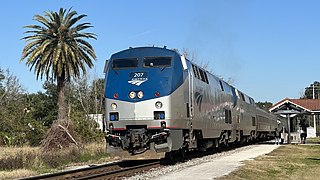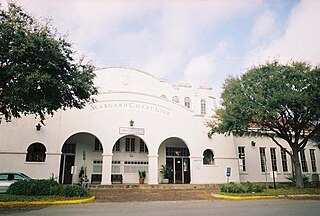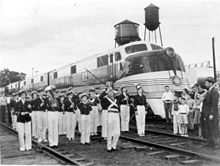
A streamliner is a vehicle incorporating streamlining in a shape providing reduced air resistance. The term is applied to high-speed railway trainsets of the 1930s to 1950s, and to their successor "bullet trains". Less commonly, the term is applied to fully faired upright and recumbent bicycles. As part of the Streamline Moderne trend, the term was applied to passenger cars, trucks, and other types of light-, medium-, or heavy-duty vehicles, but now vehicle streamlining is so prevalent that it is not an outstanding characteristic. In land speed racing, it is a term applied to the long, slender, custom built, high-speed vehicles with enclosed wheels.

The Seaboard Air Line Railroad, which styled itself as "The Route of Courteous Service", was an American railroad that existed from April 14, 1900, until July 1, 1967, when it merged with the Atlantic Coast Line Railroad, its longtime rival, to form the Seaboard Coast Line Railroad. Predecessor railroads dated from the 1830s and reorganized extensively to rebuild after the American Civil War. The company was headquartered in Norfolk, Virginia, until 1958, when its main offices were relocated to Richmond, Virginia. The Seaboard Air Line Railway Building in Norfolk's historic Freemason District still stands and has been converted into apartments.

The Atlantic Coast Line Railroad was a United States Class I railroad formed in 1900, though predecessor railroads had used the ACL brand since 1871. In 1967, it merged with long-time rival Seaboard Air Line Railroad to form the Seaboard Coast Line Railroad. Much of the original ACL network has been part of CSX Transportation since 1986.

The Louisville and Nashville Railroad, commonly called the L&N, was a Class I railroad that operated freight and passenger services in the southeast United States.

The Silver Meteor is a long-distance passenger train operated by Amtrak between New York City and Miami, Florida. Introduced in 1939 as the first diesel-powered streamliner between New York and Florida, it was the flagship train of the Seaboard Air Line Railroad (SAL) and one of the flagship trains of its successor, the Seaboard Coast Line Railroad (SCL). The train was transferred to Amtrak when it took over intercity passenger rail service in 1971.

The Silver Star is a long-distance passenger train operated by Amtrak on a 1,522-mile (2,449 km) route between New York City and Miami via Washington, D.C., Richmond, Virginia, Raleigh, North Carolina, Columbia, South Carolina, Savannah, Georgia, Jacksonville, Florida, and Tampa, Florida. The Silver Star and its sister train in the Silver Service brand, the Silver Meteor, are the descendants of numerous long-distance trains that operated between Florida and New York for most of the 20th century.

Orlando Health/Amtrak station, also known as Orlando station, is a train station in Orlando, Florida. It is served by Amtrak, the national railroad passenger system of the United States, and SunRail, the commuter rail service of Greater Orlando, as well as local and intercity buses. It serves Amtrak's Silver Meteor and Silver Star lines. Built in 1926, the historic station is located in Downtown Orlando approximately one mile south of the central business district, near the campus of Orlando Health. Serving 160,442 passengers at last measure in 2013, The station is Amtrak's fifth busiest in the Southeastern United States; it is the second busiest Amtrak station in Florida, behind the Sanford station of the Auto Train.

Orange Blossom Special is the 21st album released by musician Johnny Cash on Columbia Records in 1965. The recordings include country and folk standards, such as "The Long Black Veil", "When It's Springtime in Alaska", "Danny Boy" and "Wildwood Flower".
"Orange Blossom Special" is a fiddle tune about the luxury passenger train of the same name. The song was written by Ervin T. Rouse (1917–1981) in 1938 and was first recorded by Rouse and his brother Gordon in 1939. Often called simply "The Special" or "OBS", the song is commonly referred to as "the fiddle player's national anthem".

The Texas Zephyr was a named passenger train operated by the Colorado & Southern Railway and the Fort Worth & Denver Railway. The train was originally designated number 1 southbound, and number 2 northbound.

The Champion was a streamlined passenger train operated by the Atlantic Coast Line Railroad and Florida East Coast Railway between New York City and Miami or St. Petersburg, Florida. It operated from 1939 until 1979, continuing under the Seaboard Coast Line and Amtrak. It was a direct competitor to the Seaboard Air Line Railway's Silver Meteor, the first New York-Florida streamliner.
The Gulf Wind was a streamlined passenger train inaugurated on July 31, 1949, as a joint operation by the Louisville and Nashville Railroad and the Seaboard Air Line Railroad. The Gulf Wind replaced the heavyweight New Orleans - Florida Express on this routing. The Gulf Wind was a limited stops train and offered amenities such as dining cars and Pullman service. The train left Jacksonville at night and arrived in New Orleans in the evening, as the Express had done.

The City of Miami was a seven-car coach streamliner inaugurated by Illinois Central Railroad on December 18, 1940. Its route was from Chicago to Miami a total distance of 1,493 miles (2,403 km).

Wildwood station is a bus station, and former train station, in Wildwood, Florida. It serves Amtrak's Thruway Motorcoach bus system and formerly served trains for Amtrak and other rail companies. The station is located on 601 North Main Street in Wildwood, Florida. Along with the northern terminus of Florida's Turnpike, the station gave Wildwood a reason to refer to itself as "The Crossroads of Florida."
Ervin Thomas Rouse was an American fiddler and songwriter, largely known for his widely recorded "Orange Blossom Special" (1938) bluegrass standard. He also wrote the 1940s Moon Mullican hit "Sweeter Than The Flowers", which has also become a bluegrass standard.
The Tampa Southern Railroad was a subsidiary of the Atlantic Coast Line Railroad (ACL) originally running from Uceta Yard in Tampa south to Palmetto, Bradenton, and Sarasota with a later extension southeast to Fort Ogden in the Peace River valley built shortly after. It was one of many rail lines completed during the Florida land boom of the 1920s. Most of the remaining trackage now serves as CSX Transportation's Palmetto Subdivision. Another short portion just east of Sarasota also remains that is now operated by Seminole Gulf Railway.
The Florida Western and Northern Railroad was a subsidiary of the Seaboard Air Line Railroad that expanded their network in the 1920s by building a rail line from Coleman, Florida all the way to West Palm Beach via Auburndale and Sebring, a distance of 204 miles. The line would be extended to Miami by the Seaboard-All Florida Railway, another Seaboard Air Line subsidiary, shortly after with the full line from Coleman to Miami becoming the Seaboard Air Line's Miami Subdivision. The line is still in service today from Auburndale to West Palm Beach and is now operated by Seaboard successor CSX Transportation as their Auburndale Subdivision.

The Dixie Flyer was a premier named passenger train that operated from 1892 to 1965 via the "Dixie Route" from Chicago and St. Louis via Evansville, Nashville, and Atlanta to Florida. However, the train continued until 1969 as an Atlanta to Florida operation, run solely by the Atlantic Coast Line Railroad and its successor, the Seaboard Coast Line. The Flyer's route varied in early years, but by about 1920 was set as follows:

The Seminole, also known as the Seminole Limited, was a passenger train operated by the Illinois Central Railroad, Central of Georgia Railway, and Atlantic Coast Line Railroad between Chicago, Illinois and Jacksonville, Florida. It operated from 1909 to 1969 and was the first year-round service between the two cities.
The Seaboard Air Line Railroad’s Main Line was the backbone of the Seaboard Air Line Railroad's network in the southeastern United States. The main line ran from Richmond, Virginia to Tampa, Florida, a distance of over 800 miles. Along its route it passed through Petersburg, Raleigh, Columbia, Savannah, Jacksonville, and Ocala, Florida. While some segments of the line have been abandoned as of 2022, most of the line is still in service and is owned by the Seaboard Air Line's successor, CSX Transportation as their S Line.















